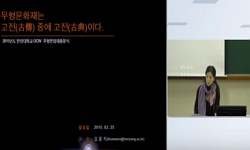The funeral rite is one of the most important rite of passage in the Korean life. It consists of the major religious rituals of Confucianism, Buddhism, and Shamanism in Korea. It is, at the same time, the valuable performing arts comprising song, musi...
http://chineseinput.net/에서 pinyin(병음)방식으로 중국어를 변환할 수 있습니다.
변환된 중국어를 복사하여 사용하시면 됩니다.
- 中文 을 입력하시려면 zhongwen을 입력하시고 space를누르시면됩니다.
- 北京 을 입력하시려면 beijing을 입력하시고 space를 누르시면 됩니다.

진도 상장례 음악의 공연학적 구조와 음악적 상징에 관한 연구-무형문화재 지정종목을 중심으로- = A Musical Study of the Funeral Ritual on Jindo Island
한글로보기https://www.riss.kr/link?id=A101614583
-
저자
이용식 (전남대학교)
- 발행기관
- 학술지명
- 권호사항
-
발행연도
2012
-
작성언어
Korean
-
주제어
진도 ; 상장례 ; 통과의례 ; 씻김굿 ; 다시래기 ; 만가(輓歌) ; 공연학 ; 중요무형문화재 ; Jindo Island ; funeral ritual ; Shamanism ; Ssitgim-gut(celasing ritual) ; Dasiraegi(drama) ; funeral songs ; performance theory ; Intangible Cultural Heritage
-
등재정보
KCI등재후보
-
자료형태
학술저널
-
수록면
265-289(25쪽)
-
KCI 피인용횟수
0
- 제공처
- 소장기관
-
0
상세조회 -
0
다운로드
부가정보
다국어 초록 (Multilingual Abstract)
The funeral rite is one of the most important rite of passage in the Korean life. It consists of the major religious rituals of Confucianism, Buddhism, and Shamanism in Korea. It is, at the same time, the valuable performing arts comprising song, music, and dance. The Shamanic ritual, especially, is the most artistic ritual which is performed to lead the soul of the dead to the nirvana.
The Jindo Island, located in the southwestern tip of the Korean peninsula, is famous for its preservation of traditional funeral ritual in Korea. The island's ritual is composed of the Shamanic ritual, called Ssitgim-gut(cleasing ritual), the drama, called dasi raegi, performed by special entertainers, and funeral songs. They such precious performing arts that they are designated as Intangible Cultural Heritage by the central and provincial governments. In this way, the funeral ritual of the Jindo Island exhibits the national traits as well as the local characteristics. In this paper, I will explore the funeral rites of the island in the view of the performing arts to discover the meaning and characteristics of the island's culture.
The funeral rites on Jindo Island are located in the liminal zone between this world and the other world. They are at the same time a chaotic space where the living and the dead coexist. The ritual can be distinguished in three parts. The first part is the rite of separation when the dead is confirmed and separated from this world. In this stage, the Confucian ritual is performed without any music and dance. The second part is the abnormal condition when the living and the dead coexist to console the soul of the dead. In this part, the Shamanic ritual and the drama is performed by professional artists. The third part is the rite of aggregation to send the soul of the dead to the nirvana. In this part, the holders of the coffin sings the song which functions as the ritual song as well as the labor song. In this way, the funeral rite of the Jindo Island is the most precious cultural heritage which shows the artistic beauty and identity of Korea.
국문 초록 (Abstract)
상장례(喪葬禮)는 가장 중요한 통과의례(通過儀禮, rites of passage)로 꼽힌다. 상장례는 유교식 제의와 불교식 재(齋), 그리고 무교(巫敎)식 천도(遷度)굿이 어우러지는 우리나라 종교의례의 결...
상장례(喪葬禮)는 가장 중요한 통과의례(通過儀禮, rites of passage)로 꼽힌다. 상장례는 유교식 제의와 불교식 재(齋), 그리고 무교(巫敎)식 천도(遷度)굿이 어우러지는 우리나라 종교의례의 결정체이다. 이는 엄숙한 종교의식과 더불어 망자의 혼을 위무하는 악가무(樂歌舞)가 어우러지는 공연예술(performing arts)적 성격을 갖는 판이기도 하다. 특히 망자를 극락왕생으로 천도하기 위해 거행되는 무교 의례인 천도굿은 종교의례인 동시에 공연예술로서 전통적인 상장례의 백미(白眉)를 장식하는 중요한 통과의례 절차이다.
전라남도 진도는 아직도 전통적인 상장례를 충실히 보존하는 것으로 알려져 있다. 진도에서는 무교 의례인 씻김굿을 비롯하여 망자의 혼을 놀리는 다시래기와 관을 운구하고 하관하면서 부르는 만가(輓歌)가 중요무형문화재 및 지방무형문화재로 지정되어 보존되고 있다. 이런 점에서 진도의 상장례는 우리나라 상장례의 전형적인 모습과 진도의 독특한 모습을 아울러 볼 수 있는 문화연행이다. 이글에서는 문화연행으로서의 진도 상장례를 고찰하여 진도의 문화구조를 파악하고 그 문화적 의미와 특징을 밝히는 것을 목적으로 한다.
진도 상장례는 이승과 저승의 중간에 위치한 전이 지점(liminal zone)이자 삶과 죽음이 공존하는 혼돈과 무질서의 공간이기도 하다. 상장례는 3부분으로 나눌 수 있는데, 첫 단계는 망자의 죽음을 확인하고 알림으로써 이승으로부터 분리시키는 분리의식(rite of separation)이다. 이 단계는 유교식 의례이며 음악이 연행되지 않는다. 상장례의 정점은 씻김굿과 다시래기이다. 이 단계는 삶과 죽음이 공존하면서 갈등을 조장하고 죽음을 달래는 비일상상태(abnormal condition communitas)이다. 그리고 마지막 단계는 망자의 넋을 저승으로 보내는 통합의식(rite of aggregation)이다. 이 단계에서는 운상과 하관을 위해 만가를 부르는데, 만가는 내용적으로는 종교요이고 기능적으로는 노동요이다. 이렇게 진도의 상장례는 의례적인 의미뿐만 아니라 음악적 상징성을 갖는 공연예술로서의 귀중한 가치를 갖는 것이다.
참고문헌 (Reference)
1 이용식, "황해도 굿의 음악인류학" 집문당 2006
2 허순선, "호남의 곽머리씻김굿" 민속원 2009
3 국립국악원, "한국의굿: 진도씻김굿, In 한국음악 제34집" 국립국악원 2003
4 유종목, "한국민간의식요연구" 집문당 1990
5 이용식, "한국 음악의 뿌리 팔도 굿 음악" 서울대학교출판부 2009
6 이윤선, "진도지역 상례를 통해서 본 의례와 놀이의 연행 의미" 비교민속학회 38 (38): 85-125, 2009
7 박미경, "진도씻김굿의 즉흥성 연구 점정(點睛), In 남도음악의 생성구조와 즉흥성" 국립남도국악원 2008
8 박정경, "진도씻김굿의 음악적 내용, 한국의 굿: 진도씻김굿, In 한국음악 제34집" 국립국악원 2003
9 나경수, "진도만가" 국립남도국악원 2007
10 박미경, "진도 씻김굿의 서사무가 제석굿의 음악적 구성" 한국국악학회 32 : 109-129, 2002
1 이용식, "황해도 굿의 음악인류학" 집문당 2006
2 허순선, "호남의 곽머리씻김굿" 민속원 2009
3 국립국악원, "한국의굿: 진도씻김굿, In 한국음악 제34집" 국립국악원 2003
4 유종목, "한국민간의식요연구" 집문당 1990
5 이용식, "한국 음악의 뿌리 팔도 굿 음악" 서울대학교출판부 2009
6 이윤선, "진도지역 상례를 통해서 본 의례와 놀이의 연행 의미" 비교민속학회 38 (38): 85-125, 2009
7 박미경, "진도씻김굿의 즉흥성 연구 점정(點睛), In 남도음악의 생성구조와 즉흥성" 국립남도국악원 2008
8 박정경, "진도씻김굿의 음악적 내용, 한국의 굿: 진도씻김굿, In 한국음악 제34집" 국립국악원 2003
9 나경수, "진도만가" 국립남도국악원 2007
10 박미경, "진도 씻김굿의 서사무가 제석굿의 음악적 구성" 한국국악학회 32 : 109-129, 2002
11 채정례, "진도 단골 채정례 구술채록 연구: 채정례의 삶과 예술" 국립남도국악원 2005
12 이경엽, "진도 다시래기 연희본의 비교 연구" 한국공연문화학회 11 (11): 103-132, 2005
13 박미경, "즉흥성연구의 시안: 채보와 비교를 통한 해석" 세계음악학회 (7) : 35-64, 2002
14 이경엽, "중요무형문화재 제81호: 진도다시래기" 국립문화재연구소 2004
15 황루시, "중요무형문화재 제72호 진도씻김굿" 화산문화 2001
16 문화재관리국, "무형문화재종합조사보고서: 전라남도국악실태조사" 문화재연구소 1980
17 이경엽, "무형문화재와 민속 전승의 현실" 한국민속학회 40 : 293-332, 2004
18 이용식, "경상북도 서사민요의 음악적 연구 -<이선달네 맏딸애기>에 기하여-" 한국민요학회 11 : 137-171, 2002
19 Singer, Milton B, "The great tradition in a metropolitan center: Madras, In Traditional India: Structure and Change" Ameircan Folklore Society 1958
20 List, George, "The boundaries of speech and song" Ethnomusicology 1963
21 Turner, Victor, "The Ritual Process: Structure and Anti-structure" Cornell University Press 1969
22 Yoichi, Yamada, "Songs of Spirits: An Ethnography in Sounds in a Papua New Guinea Society. Papua New Guinea, Institute of Papua New Guinea Studies"
23 Alexander, Nikolai A, "Shamans and their religious practices from shamanism among the Turkic peoples of Siberia, In Shamanic Worlds: Rituals and Lore of Siberia and Central Asia" North Castle Books 1997
24 Leach, Edmund, "Culture & Communication" Cambridge University Press 1976
동일학술지(권/호) 다른 논문
-
- 국립국악원
- 정경란
- 2012
- KCI등재후보
-
국악치유론 기반을 위한 동양학적 이론 근거 모색 -황제내경(黃帝內徑)과 예기(禮記) 악기(樂記)에 나타난 ‘오행감정(五行感情)’을 중심으로-
- 국립국악원
- 박정련
- 2012
- KCI등재후보
-
기악(伎樂)의 변모 양상 -악기 편성과 곡목을 중심으로-
- 국립국악원
- 이지선
- 2012
- KCI등재후보
-
- 국립국악원
- 윤아영
- 2012
- KCI등재후보
분석정보
인용정보 인용지수 설명보기
학술지 이력
| 연월일 | 이력구분 | 이력상세 | 등재구분 |
|---|---|---|---|
| 2027 | 평가예정 | 재인증평가 신청대상 (재인증) | |
| 2021-01-01 | 평가 | 등재학술지 유지 (재인증) |  |
| 2018-01-01 | 평가 | 등재학술지 유지 (등재유지) |  |
| 2015-01-01 | 평가 | 등재학술지 선정 (계속평가) |  |
| 2013-01-01 | 평가 | 등재후보학술지 유지 (기타) |  |
| 2011-01-01 | 평가 | 등재후보학술지 선정 (신규평가) |  |
학술지 인용정보
| 기준연도 | WOS-KCI 통합IF(2년) | KCIF(2년) | KCIF(3년) |
|---|---|---|---|
| 2016 | 0.41 | 0.41 | 0.4 |
| KCIF(4년) | KCIF(5년) | 중심성지수(3년) | 즉시성지수 |
| 0.33 | 0.29 | 1.006 | 0.05 |




 스콜라
스콜라







